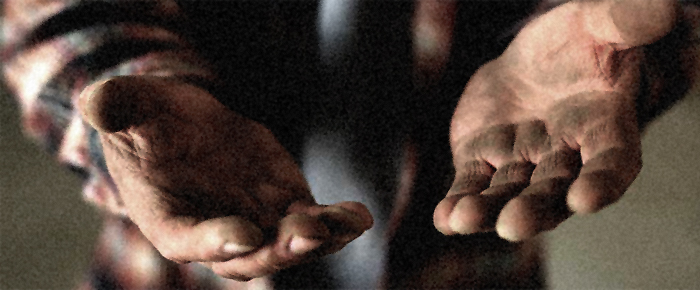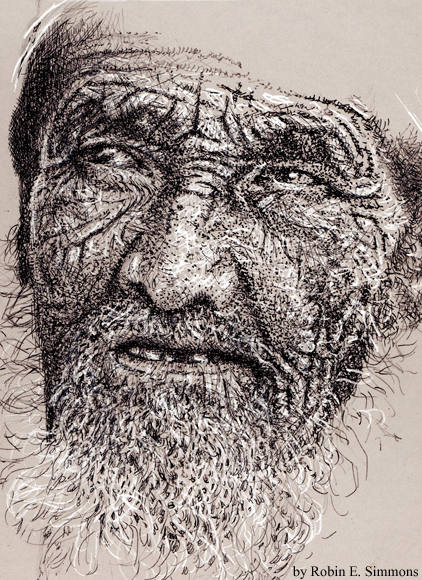
By Heidi Simmons
 “This is just the way life is,” said Eli, a homeless man sitting with Rocky Marciano a protective little white dog that belongs to his friend Mike. “Everyone’s different. Life isn’t simple.”
“This is just the way life is,” said Eli, a homeless man sitting with Rocky Marciano a protective little white dog that belongs to his friend Mike. “Everyone’s different. Life isn’t simple.”
Celebrating his 70th birthday last July, Eli is a handsome, dignified man even though he lacks most of his teeth. He was born in Greece. When he talks about his parents and the distant life there, his eyes well up.
Although his clothes are worn, they are fairly clean. He has several layers on, yet it may not have much to do with the seasonally low temperatures. He sits in the shade, his back against the Ralphs’ shopping center sign on Sunrise taking in the day. There is a hint of alcohol on his breath.
Eli first came to Palm Springs in 1977. He worked in the restaurant business bussing tables and washing dishes. He has been homeless for four years. He has no family.
But Eli is part of a larger homeless community that spends the day in Sunrise Park. He wants to wake Mike so he can talk about homelessness, but Mike is curled up on the dirt next to a short wall two yards from the busy street. He points out other friends across the street gathered in the sunny park. There are at least a dozen.
Last January, the Palm Springs City Council formed an Ad Hoc City Council Subcommittee for Homelessness and a Task Force was created to help homeless individuals.
In May, the city held a community discussion titled, “Why Addressing Homelessness Matters” at the Mizell Senior Center. The presentation defined homelessness, the efforts already in place and there was a public discussion that included homeless people taking the podium. The room was filled to standing room only.
The 12-member Task Force began monthly meetings in September. Four subcommittees were created to remedy the main issues pertaining to homelessness: Housing, Jobs, Addiction/Mental Health, and Youth.
Palm Springs reported there are 118 homeless individuals within the city. A “Point in Time Count” interviewed is 66 individuals and “Observed” — but not interviewed –- another 52 homeless individuals. At the time of the report, the homeless who live in shelters under the jurisdiction of Riverside County was not calculated.
In 2015, the valley wide “Point in Time Count” of homeless individuals is 347. The county has 1,587 “Point in Time Count” homeless individuals. According to the 2015 Annual Homeless Assessment Report to Congress, more than half of the homeless population in the US is in five states. California leads at 21 percent or 115,738 people.
The Palm Springs “Point in Time Count” in 2013 was 60, making the 2015 count an increase of 97 percent. As the population of homeless individuals has increased over the last two years, their presence has become more prominent, especially in high traffic tourist areas. Panhandling and spending nights in shop doorways has created a challenge for local businesses, city leaders and visitors.
According to Palm Springs Police Department Lieutenant Kovaleff, the chronically homeless remain throughout the year, but the unsheltered and transient population can change day-to-day regardless of the season.
The most common homeless infraction is unlawful camping.
Regarding the homeless and crime, the PSPD has no markers to identify a suspect or victim as “homeless.”
“While it is possible to identify people as transient by their reported address, many homeless individuals have a mailing address [or lack of address] that make this method of estimation inaccurate,” said Kovaleff. “The officer may mention the person’s housing situation in their report, but this search would be overwhelming.”
The PSPD is acutely aware that people become homeless for a variety of reasons. “Many become homeless due to lack of affordable housing, decreased employment opportunities, lack of affordable health care, mental illness, substance abuse or domestic violence,” said Kovaleff.
While some Palm Springs residents lose their housing and become homeless, others migrate to Palm Springs for a variety of reasons.
“PSPD has a long history of being compassionate to all members of the community, including those who are homeless,” said Kovaleff. “We understand that other factors may come into play, and no two stories are alike.”
The mission statement of PSPD states: “The men and women of the Palm Springs Police Department, empowered by and in partnership with the community, are dedicated to providing professional, ethical, and courteous service to all.”
The PSPD has taken a leadership role to better serve and make positive changes in the community.
“In our day-to-day duties, it is common to have interaction with the homeless and it’s important to recognize that without law enforcement’s intervention, many of these individuals will continue to fall into despair, while decompensating and eventually dying on our streets,” said Kovaleff. “Homelessness will never be solved by issuing tickets, arresting individuals, or any other type of enforcement action. We have personnel who work to direct members of our homeless community towards the appropriate resources and handle the calls associated with homelessness.”
Riverside County has agreed to partner with the City of Palm Springs to establish a Mental Health Homeless Outreach Team. The city has committed $165,000 per year for a behavioral health specialist and a mental health peer specialist.
The mental health staff is expected to come on board in the beginning of the new year and will work closely with the Palm Springs Police Department.
A December 9 press release stated: “The goals of the partnership include: providing care and alternatives to those at risk of injury or death without appropriate mental health and substance use homeless services; reducing jail incarcerations and involuntary mental health treatment and hospitalizations, and linking hard-to-reach homeless individuals to community resources.”
Homeless populations include the employed homeless, the mentally ill and/or substance abusing homeless and the habitually homeless. The habitually homeless sometimes resist the label of homeless and reject the idea that they need assistance or services.
I ask Eli if he would like to live in a house and he has trouble answering. He still has a Greek accent and doesn’t like the question. He mumbles and changes the subject. He tries to wake his friend to answer the question.
Being hungry doesn’t seem to be an issue for Eli either. He says he gets food from churches and points across the street to either the Mizell Center or the Boys and Girls Club or his family of homeless men and women in the park. But again, he changes the subject.
Once you get Eli talking, he becomes animated and excited to be involved in a conversation. He talks about his name Eli – short for Elisha (?). He tells the story of how the Biblical Elijah was hated and cast out of the city. “Nobody liked him,” Eli says. He shares that Elijah was alone and homeless in the desert and fed by birds. Eli continues describing how from a fiery chariot, Elijah tossed Elisha his magical coat passing on his power.
Whether Eli is fully aware of the allegory to his life, it’s not clear. But certainly, he is glad to have a pleasant conversation about anything other than his homelessness.












































